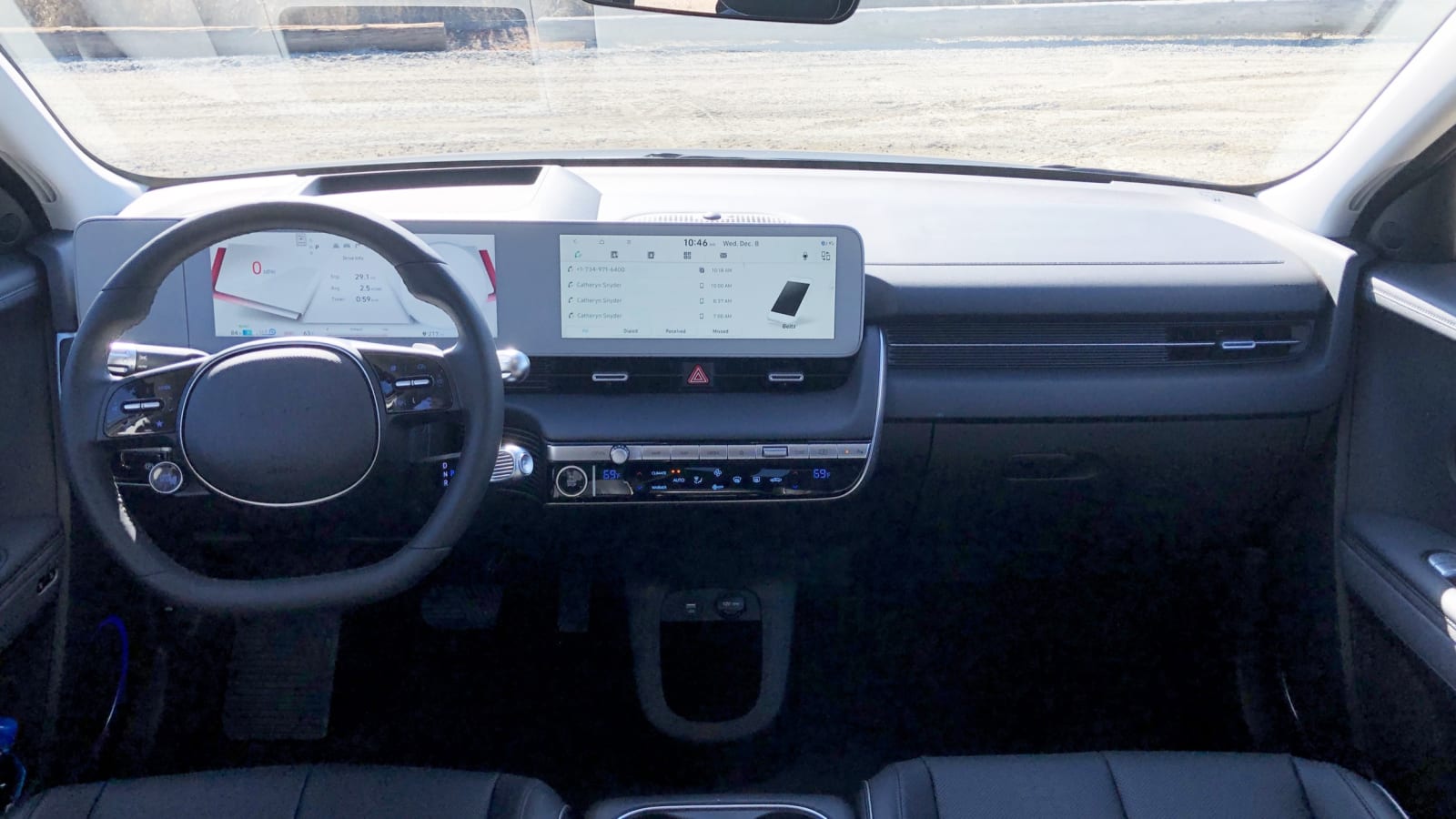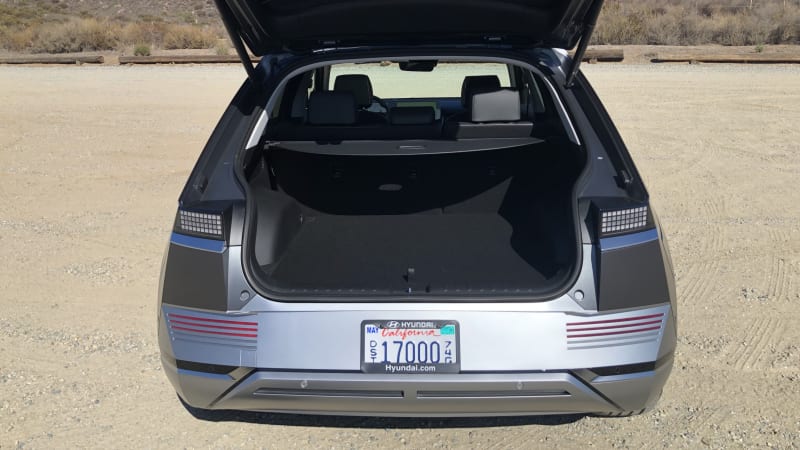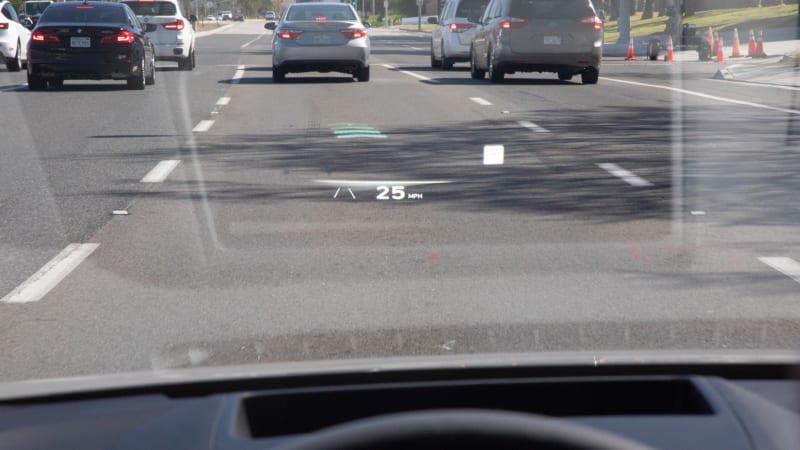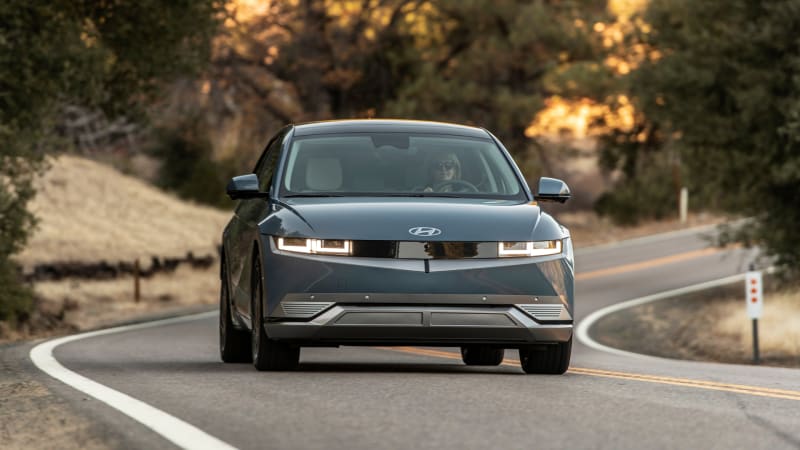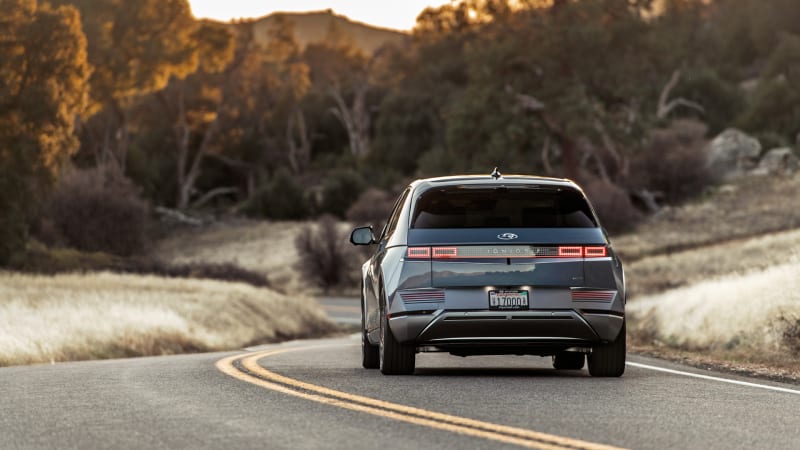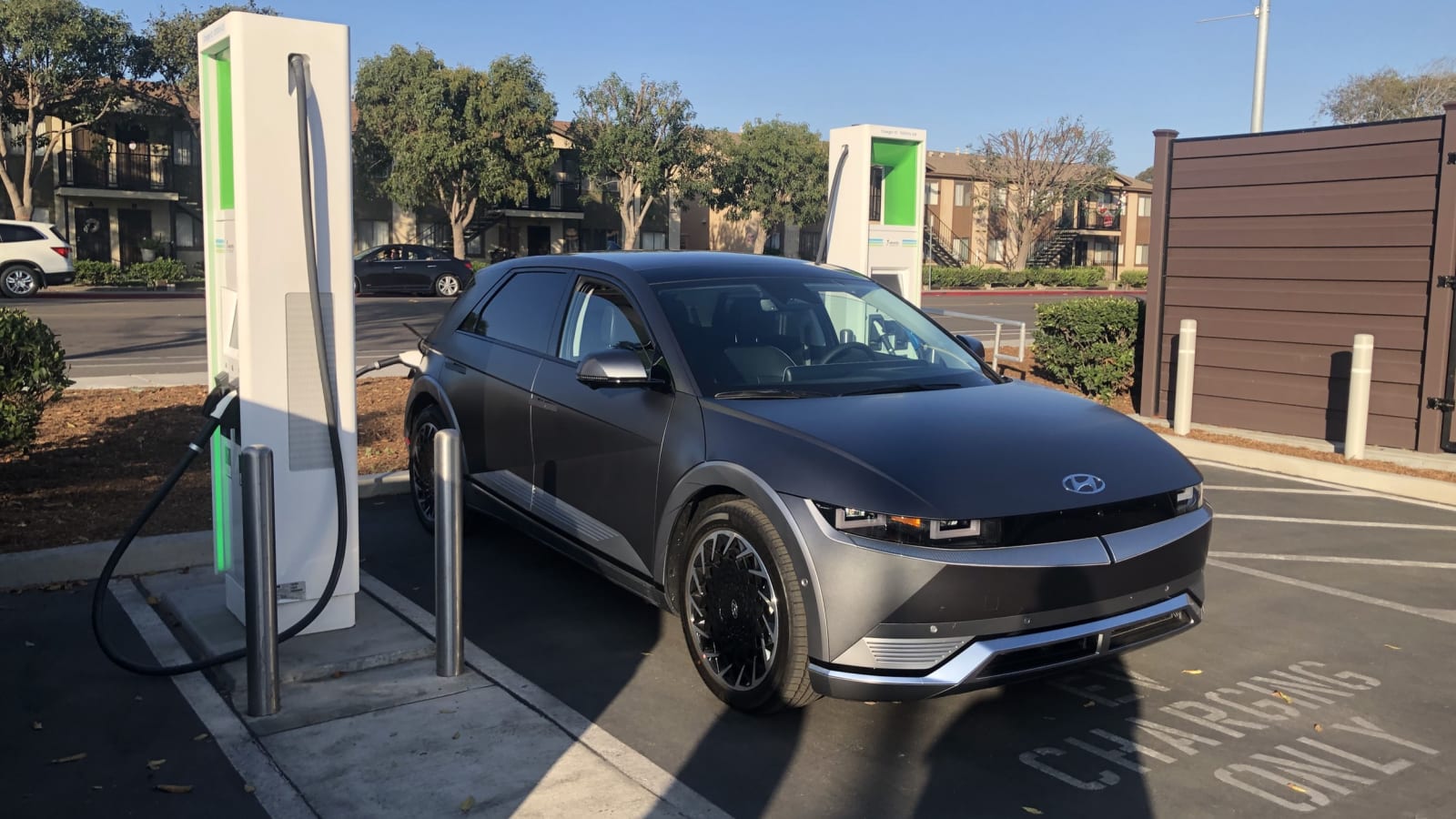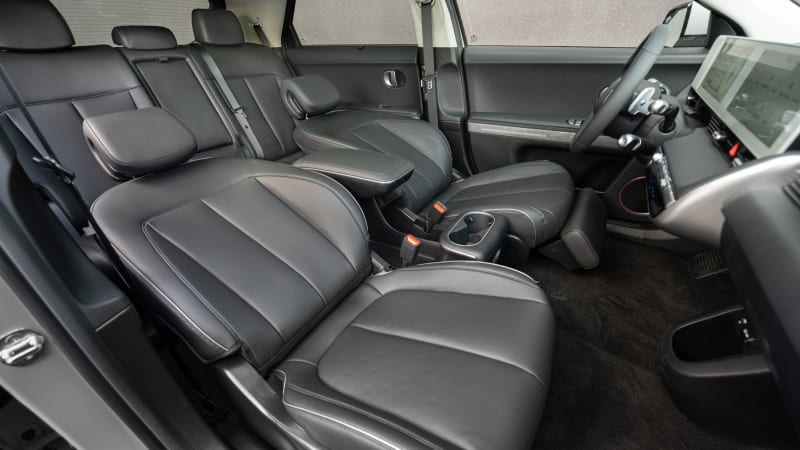SAN DIEGO — Hyundai has hit a tremendous stride as it refreshes and expands its product lineup. It’s creating attractive vehicles that are selling well, full of competitive content at a competitive price. Tech, design, safety, usability, drivability and value permeate the lineup, and its performance-focused N vehicles are a blast to hustle around, too. We’ve said it before: Hyundai, its sister brand Kia, and now its burgeoning luxury marque Genesis are entering a golden age. Interestingly, this promising momentum is building at the same time as a huge shift in the automotive industry. Sure, Hyundai’s internal-combustion-powered vehicles are hitting that aforementioned stride, but can the Korean automaker keep the hits coming in the EV age? Enter the 2022 Hyundai Ioniq 5, the brand’s first, dedicated all-electric nameplate.
So far, this first EV built on Hyundai’s new Electric Global Modular Platform (E-GMP) sure looks promising. Labeled a crossover by Hyundai, but maybe more recognizable as a large hatchback, it has unique, eye-catching styling that is unmistakably meant to advertise its futuristic (read: electric) personality. It does so without looking dorky, though, with sporty proportions, a wheelbase longer than that of the Palisade, short overhangs, complicated wheels, flush door handles, a dramatic slash of a character line and splashy but organized lighting front and rear. Even its exterior color palette seems like it could be drawn from sci-fi filmography: a white, two grays and a black, with the two “colorful” options — Digital Teal and Lucid Blue — only straying slightly from grayscale.
Inside, things get even more different, with a unique twist on the minimalism that increasingly defines electric vehicles. A two-spoke, flat-bottom steering wheel sports no central badge, and has a wide rim to expand the view of the 12-inch digital tablet-style instrument screen behind it. To the right of that screen, in the same rectangular housing, is the 12-inch infotainment touchscreen. The interior lines are very horizontal, from the dash to the vents to the armrests. The center console is moveable, sliding forward and backward, and is home to a pair of cupholders, a large cargo tray, a slot for a phones — with an available wireless charging pad — and a pair of USB ports. It’s a clean and calming space, surprisingly spacious and airy. Again, the color palette is limited: black monotone, two-tone gray or two-tone green. The latter is only available with the Digital Teal or Shooting Star exterior on the SEL and Limited trim levels.
In back, the rear seats can slide fore and aft to manage legroom and cargo space. On paper, the Ioniq 5 has 133.7 cubic feet of interior volume, which is more than the VW ID.4’s 130.2 and the Mustang Mach-E’s 130.8 cubes. Cargo volume is slightly less than those, at 27.2 cubic feet, compared to the Mach-E’s 29.7 and the ID.4’s 30.3. The cargo area seems perfectly usable, despite the sharp angle of the rear glass, but we’ll withhold our judgement until we can get an Ioniq 5 in our driveway or grocery store parking lot to put it to the test.
Many of the cabin materials come from sustainable sources. The SEL trim features seats and armrests covered in a leatherette made from recycled plastic bottles. The seats are perforated, and incorporate a faint stripe of repeating squares up the left side. The dashboard and door panels feature a polyurethane paint made from bean oil. The garnish on the sides of the door armrests is Tyvek (a plastic fiber, but a recyclable one), and the carpet and headliner are made from a bio-plastic (polyethylene terephthalate) that incorporates material extracted from sugar cane. In addition to lessening the car’s environmental impact, the materials help provide a high-quality feel in the cabin.
Once turned on, the Ioniq 5 puts an important piece of technology directly in front of the driver in the form of an available head-up display with integrated augmented reality. In addition to the usual HUD duties, it can also project images to highlight the car ahead of you, give alerts about lane safety and help indicate where and when to make the next turn on your route. If that sounds like a lot of visual information, it is, but you can tailor the content shown in your HUD through menu selections. At present the only other cars out there with this type of technology are the Mercedes-Benz S-Class and EQS.
In the U.S., the Ioniq 5 is offered with a rear-wheel-drive or all-wheel-drive powertrain. Both feature the same 77.4-kilowatt-hour battery, which is good for an impressive 303 miles of range with RWD, or a still-respectable 256 miles with AWD. The RWD model features a single electric motor at the rear, providing 225 horsepower and 258 pound-feet of torque. Hyundai estimates a 0-62-mph (100 km/h) time of 7.3 seconds for the RWD version. The AWD model adds a 74-kW motor up front for a total of 320 hp and 446 lb-ft of torque, propelling the car to 62 mph in 5.1 seconds.
Both the RWD and AWD models come with a modest selection of drive modes. Besides the usual parameters, they also govern the power distribution in the dual-motor Ioniq 5. Normal mode is balanced, with the full amount of power available and a good mix of two-motor and single-motor driving using the front-motor disconnect for maximum efficiency. Eco mode limits maximum output to a total of 225 horsepower, limiting the peak launch to 0.45g, down from the maximum 0.75g. It also highly favors rear-wheel drive, leaving the front motor dormant most of the time. Sport mode keeps both motors engaged, unleashes its full accelerative force and splits torque as needed depending on what the conditions call for. It also ups the steering heft, though we found that only appealing on a winding road and wished there was a mix-and-match custom setting. Finally, there’s a Snow mode, which uses all-time all-wheel drive using a 50/50 torque split, while limiting the regen to its two weakest settings for maximum traction and stability — but it still makes the full 320 hp.
If you are finicky about regenerative braking force, you can customize that on the fly thanks to paddles on the steering wheel that toggle through the four levels of regen. This is a great setup if, like us, you like being able to change regen levels based on traffic and driving conditions, including managing speed on downhill grades.
Our drive took place in the quicker, dual-motor variant. With all the headline-generating, eye-popping 0-60 times of ultra EVs like the Tesla Model S Plaid, it’s easy to forget that a 5-second 0-60 time is still awfully quick. The Ioniq 5’s instant torque snapped us back into our seats as we rocketed onto the freeway out of downtown San Diego. Later on, we gleefully punched our way out of each turn in a series of tight, mountainous curves. With Sport mode engaged, we were totally tickled to find that the Ioniq 5 will treat you to a light but delectable serving of the rear wheels breaking traction to let the rear end peek out to say hello. It’s an addictive treat, and one that never failed to make us giggle.
Yet, we liked how the Ioniq easily switched from such exciting, engaging driving to relaxed, low-effort cruising. With its long wheelbase, the Ioniq 5 is also smooth and stable on the highway. Wind noise is very well managed, and most surfaces kept tire noise at a minimum.
The Ioniq 5 effectively gets the Genesis suite of driver assistance systems due to the inclusion of its Highway Driving Assist II feature. This adds machine learning to match your driving style and semi-automated lane changes to the otherwise equal and excellent adaptive cruise control and lane-centering system found in other Hyundais. HDA II’s integration within the AR HUD would be a wrinkle unique to the Ioniq 5, however. Other safety features we already know and love are included, too: forward collision warning with pedestrian and cyclist detection, rear cross-traffic warning, surround-view monitor and the Autoblog Tech of the Year-winning multi-point blind-spot warning suite that includes a camera feed in the instrument panel.
The Ioniq 5 aims to take the pain out of public charging with its 800-volt battery pack, the first implementation of such architecture apart from the Porsche Taycan and Audi E-Tron GT. It’s capable of charging at a rate of up to about 235 kW — and we witnessed it charging just shy of that rate at a 350-kW Electrify America charger. At just such a capable DC plug, it can charge from 10-80% in just 18 minutes. Put another way, at an 800-volt, 250-kW DC fast charger, the rear-drive Ioniq 5 will get 68 miles back into its pack in just five minutes. The same five-minute splash at an 800-volt, 150-kW charger will provide about 42 miles of driving range. Sure, it’s still not the convenience of a quick fill-up at a gas station, but it’s much closer than what we’re used to – if you can find a capable charger and that’s still a relatively large “if” for the time being. A small detail we appreciated was the vertical lighting element on the car’s nose that shows the state of charge as the square pixels fill up along with the battery.
There are a few other clever features in the Ioniq that we didn’t get the chance to try out. For instance, it’s capable of vehicle-to-load energy usage. With an adapter, you can use the vehicle’s drive battery to power appliances or whatnot, and you can even pass electrons to another EV. The Ioniq also has phone-as-key capability like other Hyundais, plus the Hyundai BlueLink app that allows you to do things like schedule charging, condition the interior climate, lock/unlock the car and start/stop the car remotely. Finally, the driver’s seat reclines, complete with a legrest, for when you want to kick back and relax while the car is charging or when waiting to pick up the kids at school. We were too excited by the actual act of driving that we completely forgot to stop and take advantage of this cozy chair. We’ll make sure to write up a 2022 Hyundai Ioniq 5 First Nap Review the next time around.
So, there are things to look forward to when we can get an Ioniq 5 for a longer loan. And, yes, we’re thoroughly excited to spend more time in the new Ioniq. It’s one of the best EVs we’ve driven, and one this author would seriously consider owning as a daily driver. It’s a quiet and comfortable car that’s also quick, capable and eager to play along on your favorite back roads. Granted, we only drove the top-trim, AWD model, so we’re hoping that the lower trims and the less-powerful but longer-range RWD version live up to their price points.
Speaking of which, Hyundai has released pricing information since our drive of the Ioniq 5. It starts at $40,925, including destination but before incentives, for the lower-range, rear-drive SE that doesn’t arrive until spring of 2022. Later this month, the full-range versions will arrive at dealerships, starting at $44,875 for the SE RWD or $48,375 for the SE AWD. There are also midgrade SEL trims, but the range-topping Limited AWD we drove costs $55,725. Keep in mind, though, that the $7,500 federal tax credit and potential local incentives knock that net cost back down below the $50,000 mark. Factor in that the Ioniq 5 comes with three years of free 30-minute charging sessions on the Electrify America network, with its growing stable of 800-volt chargers, and it makes it even more attractive not just as a daily commuter, but as a potential electric road-tripper. Considering the range, performance, tech and style, the asking price seems reasonable for the best version of one of our new favorite EVs.
So yes, we remain fully confident in Hyundai’s ability to carry its newly achieved standard of excellence into the electric age. We can’t wait to see what comes next, but for now, we’re thrilled to have the Ioniq 5. It looks cool in the parking lot, can make easy work of some of the most frustrating commutes and shortens time at the charger. After all that, the fact that it will still show you a fantastic time on your favorite back roads is the greatest reward of all.
Related Video:
Source: www.autoblog.com

